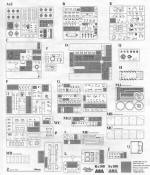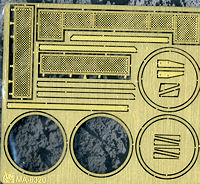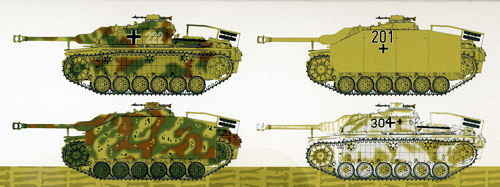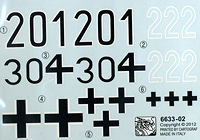
| KIT #: | 6633 |
| PRICE: | $60.00 SRP |
| MARKINGS: | Four options |
| REVIEWER: | Scott Van Aken |
| NOTES: | Smart kit |

| HISTORY |
Overall, Sturmgeschütz series assault guns proved very successful and served on all fronts as assault guns and tank destroyers. Although Tigers and Panthers have earned a greater notoriety, assault guns collectively destroyed more tanks. Because of their low silhouette, StuG IIIs were easy to camouflage and a difficult target. Sturmgeschütz crews were considered to be the elite of the artillery units. Sturmgeschütz units held a very impressive record of tank kills – some 20,000 enemy tanks by the spring of 1944.As of April 10, 1945, there were 1,053 StuG IIIs and 277 StuH 42s in service. Approximately 9,500 StuG IIIs of various types were produced until March 1945 by Alkett and a small number by MIAG.
In terms of the resources expended in their construction, the StuG assault guns were extremely cost-effective compared to the heavier German tanks, though in the anti-tank role, it was best used defensively, as the lack of a turret would be a severe disadvantage out in the open. As the German military situation deteriorated later in the war, more and more StuG guns were constructed in comparison to tanks, in an effort to replace losses and bolster defences against the encroaching Allied forces.
In 1944, the Finnish Army received 59 StuG III Ausf. Gs from Germany (30 Stu 40 Ausf.G and 29 StuG III Ausf. G) and used them against the Soviet Union. These destroyed at least 87 enemy tanks for a loss of only 8 StuGs (some of these were destroyed by their crews to avoid capture). After the war, they were the main combat vehicles of the Finnish Army until the early 1960s. These StuGs gained the nickname "Sturmi" which can be found in some plastic kit models.
StuG IIIs were also exported to other nations like Bulgaria, Hungary, Italy, Romania, and Spain.
Many German Sturmgeschütz IIIs were captured by Yugoslav Partisans. After the war, they were used by the Yugoslav Peoples Army until the 1950s.
After the Second World War, the Soviet Union donated some of their captured German vehicles to Syria, which continued to use them at least until the Six Days War (1967).
Today, examples have been kept in running condition, including one seen in the movie Mr. Bean's Holiday.
StuG III Ausf. G (Sd.Kfz. 142/1; Dec 1942– Apr 1945, 7,720 produced, 173 converted from Pz.Kpfw. III chassis): The final, and by far the most common, of the StuG series. The Ausf. G used the hull of the Pz.Kpfw. III Ausf. M. Upper superstructure was widened: welded boxes on either sides were abandoned. This new superstructure design increased its height to 2160mm. From May 1943, side hull skirts (schurzen) were fitted to G models for added armor protection particularly against anti-tank rifles. Side skirts were retro-fitted to some Ausf. F/8 models. Side skirts were also to be fitted to all front line StuGs and tanks by June 1943 in preparation for the battle of Kursk. Mountings for side skirts proved inadequate, many were lost. From March 44, improved mounting was introduced, as a result side skirts are more often seen with late model Ausf G. From May 1943, 80mm thick plates were used for frontal armor instead of two plates of 50mm+30mm. However, backlog of completed 50mm armors exited. For those, 30mm additional armors still had to be welded or bolted on, until Oct 1943.
| THE KIT |
 This is another of Dragon's fine Smart Kit productions. These kits provide you with photo-etch (and in this case that includes very nicely done steel side skirts) and individual track links in the box. This means that for most
This is another of Dragon's fine Smart Kit productions. These kits provide you with photo-etch (and in this case that includes very nicely done steel side skirts) and individual track links in the box. This means that for most modelers, there is no need for expensive aftermarket items. This kit has all of the features required to represent the July 1944 late production and that includes the nicely done Zimmerit that is already molded to the hull. The set includes photo etch for the side skirts, the side skirt attachment assembly as well as for some vents and screens as shown by the fret to the right.
modelers, there is no need for expensive aftermarket items. This kit has all of the features required to represent the July 1944 late production and that includes the nicely done Zimmerit that is already molded to the hull. The set includes photo etch for the side skirts, the side skirt attachment assembly as well as for some vents and screens as shown by the fret to the right.
Below is a full list of features.
- Newly tooled MG 34 can be optionally assembled
- Newly produced return rollers
- Travel lock w/photo-etched chain is newly produced
- Newly produced roof armor w/accurate weld seams
- Slide-skirt armor-plate brackets reproduced
- Slide-skirt armor produced in metal for scale thickness
- Injection-molded Zimmerit w/extreme details that accurately replicates the real vehicle
- Gun w/full breech assembly
- Slide-molded mantlet w/internal surface detail
- Chamfer on lower part of mantlet
- Gun breech and recoil guard fully replicated
- Recoil and recuperator cylinders are truly represented
- Slide-molded gun sleeve
- One-piece barrel
- Slide-molded muzzle brake
- Slide-molded fenders feature photo-etched parts w/upper and lower surface details
- Fender pattern accurately portrayed
- Hatches can be assembled open/closed
- Photo-etched rack on engine deck for true-to-scale appearance
- Engine deck w/interlocking structure has realistic weld seams
- Screw heads are accurately reproduced
- Delicate side-skirt brackets on fenders
- Commander's hatch w/interior details can be assembled open/closed
- Multi-directional slide-molded superstructure w/bolt detail
- Photo-etched air-intake grills
- Cooling air intakes are slide-molded
- Multi-piece upper hull easily assembled
- Radio set and seats are included
- Fully detailed hull bottom weld seams
- One-piece slide-molded lower hull w/superb details
- Floor treadplate pattern is correctly done
- Driver's vision port w/clear plastic part
- One-piece driver's vision port armor w/bolt details
- Steering-brake inspection hatch can be modeled open/closed
- Air deflector truly represented
- Photo-etched mesh is included
- Intricate OVM included
- Jack is reproduced w/multiple parts
- Final-drive housing covers are separate parts for maximum detail
- Road wheels and sprocket wheels w/accurate details
- 40cm Magic Tracks

 Markings are provided for four vehicles. Starting at the top is a vehicle from an unidentified unit on the Western Front in 1944. The all Panzer Tan vehicle is from yet another unidentified unit in 1944. The lower right camouflaged StuG is from, you guessed it, an unidentified Western Front unit in 1944. The one that is identified is the white washed one from the 904th StuG Brigage in East Prussia during 1945. The nicely done decal sheet is basically insignia and vehicle numbers.
Markings are provided for four vehicles. Starting at the top is a vehicle from an unidentified unit on the Western Front in 1944. The all Panzer Tan vehicle is from yet another unidentified unit in 1944. The lower right camouflaged StuG is from, you guessed it, an unidentified Western Front unit in 1944. The one that is identified is the white washed one from the 904th StuG Brigage in East Prussia during 1945. The nicely done decal sheet is basically insignia and vehicle numbers.
| CONCLUSIONS |
Here is yet another fine kit from Dragon and at a price that is quite reasonable for all you get in the box. These vehicles sell well so get yours while the getting is good.
| REFERENCES |
http://en.wikipedia.org/wiki/StuG_III
January 2013 Thanks towww.dragonmodelsusa.com for the preview kit. Get yours today at your local shop or on-line retailer. If you would like your product reviewed fairly and fairly quickly, please contact me or see other details in the Note to Contributors.